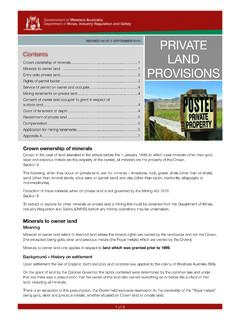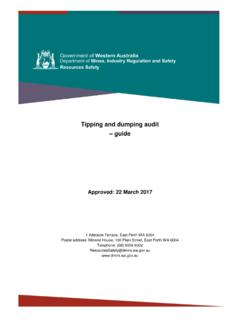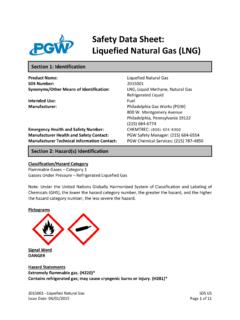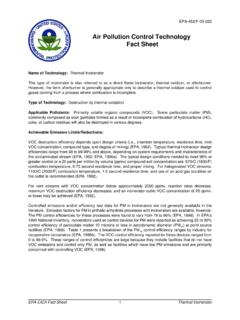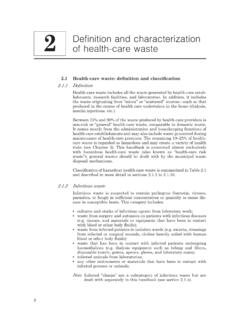Transcription of Guidelime for Petroleum Measurement and Quatity …
1 Of Western AustraliaDepartment of Mines, Industry Regulation and SafetyPetroleumGuideline for Petroleum Measurement and Quantity DeterminationGUIDELINEDate Issued16 August 2017 Target groupIndustry and GovernmentDefinitions Accuracy Verification Test (AVT): also known as a verification test; can be electronic simulations that do not involve actual flow or process comparisons under flowing conditions. Condensate: liquid formed as a result of condensation caused by reduced pressure and temperature of hydrocarbons in a gaseous state in a natural underground reservoir.
2 Custody Transfer Meter: a measuring device used in connection with purchase and sale and the calculation of taxes and royalties. Density: mass of a Petroleum fluid sample divided by its volume at specified conditions of pressure and temperature. Higher Heating Value (HHV): the number of megajoules (MJ) liberated when one cubic metre (m3) of gas is completely burnt in air and all the water formed by the combustion reaction is condensed to the liquid state, under the test conditions set down in ISO 6974 1984(E) for the analysis of the natural gas, using ISO 6976 1995(E) for the calculations from that analysis.
3 HHV for LNG loading uses GPA2261-2013 (via ISO 8943:2007). Measuring device: is used to work out, by direct Measurement , the energy, mass or volume of Petroleum transferred from one place to another. Measurement uncertainty: an expression of the result of an as measured value which characterises the range within which true value is expected to lie. Repeatability: the closeness of agreement between the results of successive measurements of the same measure and carried out under the same conditions of Measurement .
4 Reproducibility: the closeness of agreement between the results of Measurement of the same measure and carried out under changed conditions of 1 of 6 PD-RES-GDL-103D Rev 1 2 of 6 PD-RES-GDL-103D Rev 1 Tank dipping: also known as tank gauging; a process of measuring height of a liquid in a storage tank usually using a weighted graduated steel tape and bob.
5 Uplift: loading of Petroleum products into a ship s tanks . Vessel Experience Factor: the historical compilation of shore to vessel or vessel to shore cargo quantity difference and is used as a loss control tool to assess the validity of quantities derived from shore measurements. Wet Gas: Natural gas that contains less methane (typically less than 85% methane) and more ethane and other more complex hydrocarbons. Wobbe index: volume-basis calorific value, at specified reference conditions, divided by the square root of the relative density at the same specified metering reference of this document The purpose of this guideline is to provide an overview of the Measurement of Petroleum fluids, quantity determination and accounting methodologies used by the Western Australian Department of Mines, Industry Regulations and Safety (DMIRS) in the determination of royalty payments.
6 This guideline applies to Measurement of Petroleum production from Western Australia s onshore, State and territorial waters, Barrow Island and North West Shelf contextThere is a requirement for a Petroleum or geothermal energy measuring device to be approved under the Petroleum and Geothermal Energy Resources Act 1967 (PGERA67), the Petroleum (Submerged Lands) Act 1982 (PSLA82), Barrow Island Royalty Variation Agreement Act 1985 (BIRVAA85) and the Offshore Petroleum (Royalty) Act 2006 (OPRA06).Under section 147 of the PGERA67, section 148 of the PSLA82 and section 13 of the OPRA06, the quantity of recovered Petroleum or geothermal energy by a permittee, holder of a drilling reservation, lessee or licensee during a period is taken to be the quantity measured by a measuring device approved by the Minister and installed at the wellhead or at such other place as the Minister approves.
7 If there is no such measuring device or the Minister is not satisfied that such a device provides accurate or proper measurements, the quantity recovered is taken to be the quantity determined by the Minister. IntroductionRoyalty payments are required to be paid to the State and Commonwealth on Petroleum products that are recovered. An essential component in determining the royalty payable on a Petroleum product is accurate Measurement of the Petroleum products that are sold. This Measurement is conducted at the approved location, often at Petroleum custody transfer point where sale takes place.
8 There is an agreed royalty schedule to back calculate the actual production. Errors in measurements have consequences for royalty revenue, therefore it is important to ensure the accuracy of measuring equipment. For liquids where tank dipping based Measurement is used, every uplift is independently surveyed. Where possible, the government representative will also attend uplifts to audit the taking of measurements, sight and take copies of calibration certificates and use survey data to verify calculations of verification tests (AVTs) are conducted on nominated transfer flow meters (also known as a royalty meter or custody transfer meter (CTM)) and the government representative witnesses and audits these tests.
9 These tests provide independent verification of the accuracy and reproducibility of measuring devices and of the calculation 3 of 6 PD-RES-GDL-103D Rev 1 methodology applied to the determination of the quantity of Petroleum products subject to royalty payment. The AVTs are conducted over a defined extended period of time ( monthly and/or quarterly).Audits on AVTs are performed on risk basis, or as deemed necessary by DMIRS.
10 Audits are conducted by DMIRS s Petroleum Division, in some cases with the assistance of a consultant, to meet the requirements of the Western Australian Auditor General. This information will contribute to the determination of government audits cover the Measurement of: liquid hydrocarbons gaseous hydrocarbons Liquid hydrocarbon fluids include crude oil, condensate, liquefied natural gas (LNG) and liquefied Petroleum gas (LPG). Gaseous hydrocarbons refers to natural gas, including inert gas components. Measurements are also taken on gas that is flared, used for operational purposes and used for domestic of wet gas refers to the Measurement of a two phase fluid (gas and liquid) measured simultaneously in a single meter.

